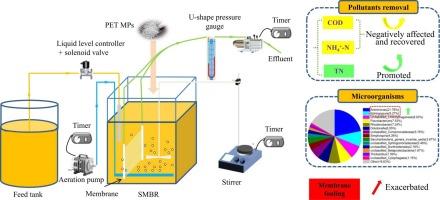聚对苯二甲酸乙二醇酯微塑料对序批式膜生物反应器模拟城市污水处理性能的影响
IF 11.3
1区 环境科学与生态学
Q1 ENGINEERING, ENVIRONMENTAL
引用次数: 0
摘要
城市污水处理厂(WWTPs)被认为是微塑料(MPs)的主要接受者,聚对苯二甲酸乙二醇酯(PET)是污水中最普遍的类型之一。然而,PET MPs对集成生物膜系统的系统性影响,特别是它们在微生物生态和膜污染中的作用,仍然知之甚少。因此,本研究评估了PET MPs对序批式膜生物反应器(SMBR)性能、微生物群落和膜污染的影响。结果表明,加入PET MPs后,MLSS从5000mg /L左右降低至4500mg /L,而MLVSS/MLSS基本保持一致。添加PET MPs后,第3天SV30和SVI由第1天的64%和128.3 mL/g迅速增加到76%和173.2 mL/g,但在随后的几天可以恢复。对于污染物的去除,COD和NH4+-N的去除一开始受到负面影响,但经过几天的运行后逐渐恢复。PET MPs的加入增强了反硝化作用,出水TN浓度由15.1±4.9 mg/L降至10.4±4.4 mg/L。PET MPs改变了活性污泥的微生物群落结构,降低了优势菌的丰度和物种多样性。Arenimonas和Sphingopyxis与PET MPs的添加关系密切。PET MPs的加入加剧了膜的生物污染,膜上微生物的多样性与活性污泥基本一致,但丰度发生了显著变化。这项研究提供了一个全面的了解PET MPs如何影响集成生物膜系统的性能。本文章由计算机程序翻译,如有差异,请以英文原文为准。

Effects of polyethylene terephthalate microplastics on performance of sequencing-batch membrane bioreactor for simulated municipal wastewater treatment
Municipal wastewater treatment plants (WWTPs) are recognized as key recipients of microplastics (MPs), with polyethylene terephthalate (PET) being among the most prevalent types in sewage. However, the systemic impact of PET MPs on integrated biological-membrane systems—especially their role in microbial ecology and membrane fouling—remains poorly understood. Therefore, the influence of PET MPs on the performance, microbial community and membrane fouling in a sequencing-batch membrane bioreactor (SMBR) was evaluated in this study. Based on the results, adding PET MPs decreased the MLSS from around 5000 mg/L to 4500 mg/L whereas the MLVSS/MLSS remain basically consistent. The SV30 and SVI increased rapidly to 76% and 173.2 mL/g on the 3rd day (from 64% and 128.3 mL/g on the 1st day) of adding PET MPs, however, they could be restored in the following days. For pollutants removal, the COD and NH4+-N removal were initially negatively affected but gradually recovered after several days of operation. The addition of PET MPs enhanced denitrification, resulting in a decrease in the effluent TN concentration from 15.1 ± 4.9 mg/L to 10.4 ± 4.4 mg/L. PET MPs changed microbial community structure and decreased the abundance of dominant bacteria and species diversity in activated sludge. Arenimonas and Sphingopyxis had strong relationships with PET MPs addition. PET MPs addition exacerbated membrane biofouling, and the microbial diversity on membrane at was basically consistent with activated sludge whereas the abundance changed significantly. This research provides a comprehensive understanding of how PET MPs affect the performance of integrated biological-membrane systems.
求助全文
通过发布文献求助,成功后即可免费获取论文全文。
去求助
来源期刊

Journal of Hazardous Materials
工程技术-工程:环境
CiteScore
25.40
自引率
5.90%
发文量
3059
审稿时长
58 days
期刊介绍:
The Journal of Hazardous Materials serves as a global platform for promoting cutting-edge research in the field of Environmental Science and Engineering. Our publication features a wide range of articles, including full-length research papers, review articles, and perspectives, with the aim of enhancing our understanding of the dangers and risks associated with various materials concerning public health and the environment. It is important to note that the term "environmental contaminants" refers specifically to substances that pose hazardous effects through contamination, while excluding those that do not have such impacts on the environment or human health. Moreover, we emphasize the distinction between wastes and hazardous materials in order to provide further clarity on the scope of the journal. We have a keen interest in exploring specific compounds and microbial agents that have adverse effects on the environment.
 求助内容:
求助内容: 应助结果提醒方式:
应助结果提醒方式:


